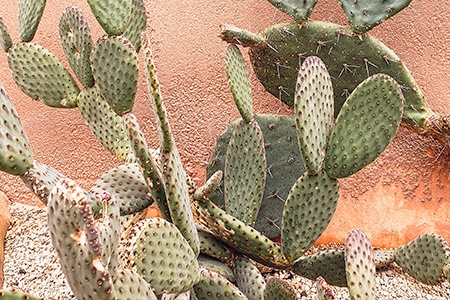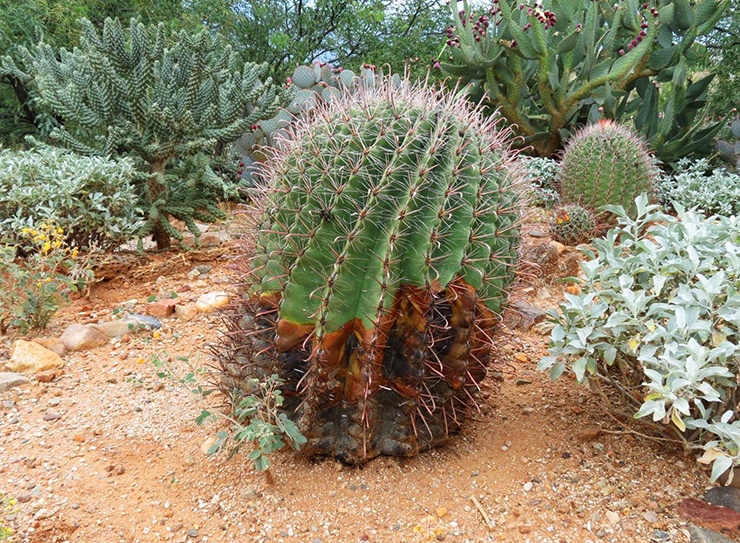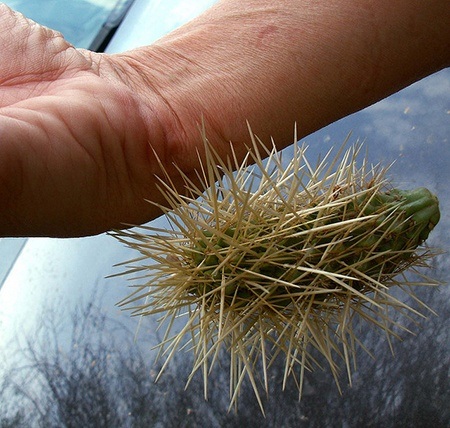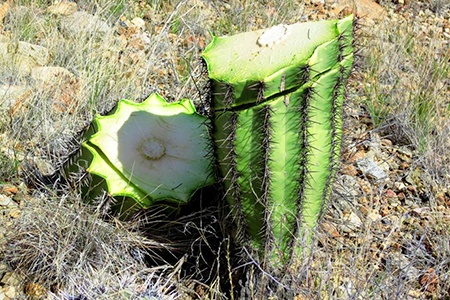How to Kill Cactus Growth in Your Yard (With or Without Chemicals)
Author: Chris Miller | Editor: Omar Alonso
Review & Research: Jen Worst & Chris Miller

I talk to a lot of people who are looking for advice on how to keep their cactus alive, but every now and then somebody needs to know how to kill cactus plants because their property is simply overrun.
It always causes me to reflect on the world, and how everything has so much to do with perspective. One person is trying their best to keep a little baby succulent alive in one part of the world, while somebody else has their yard overrun with giant cacti that they’re struggling to get rid of.
If you’re one of the people who struggles to keep a cactus alive, you may want to just stop reading now because the idea of getting rid of them probably sounds like a horror to you, but the truth is that these plants can be dangerous to pets or children, and sometimes they simply aren’t in our plans for an area.
So, here’s how to kill cactus growth once and for all, and how to safely dispose of it all when you’re done.
The Best Way to Kill Cactus Plants In Your Yard

There are two main ways to accomplish this. The first is by using chemicals to get rid of them. The second method involves physical removal, usually using some types of chainsaws or manual saws to cut it into manageable pieces. Either method is relatively safe if done right, but can also be dangerous if done improperly.
Here’s what you need to know about both methods of removing cactus from your yard:
Killing a Cactus with Herbicide
There are various mixtures of herbicide available with different ingredients. One such ingredient you’ll be on the lookout for is called picloram. An herbicide with picloram will help to eradicate a good portion of certain types of cactus.
Some people recommend adding a little dish soap into your picloram herbicide mixture to help with absorption. It’s also a good idea to use some dye, since you’re going to be spraying it onto your cactus and the dye will let you know which areas you’ve covered and which areas you’ve missed. Blue is a good color of dye to use:

Before you spray this onto the cactus, it’ll help if you damage the plant physically first. You can use any of the types of axes, a shovel, or another sharp tool to create some knicks in the cactus, allowing the spray to better permeate to the interior of the plant, rather than just sitting on the outside.
The parts you spray on the outside will still be effective, but that inside-scoop helps speed things along.
How to Get Rid of Cactus Without Chemicals
The most common way to kill a cactus or a succulent plant is by overwatering it. Overwatered cacti will turn mushy and they’ll basically rot. In this case, that doesn’t really help you a whole lot since you’ve still got to dispose of it, and that brings us to the crux of this method.
If you don’t want to use chemicals to deal with a cactus, you’ll have to rely on physical removal which simply means getting rid of it. From there, you can dispose of it in normal yard waste, compost it, or just throw it in the garage.
Different cities will have different advice or services offered for this, depending on where you live, so you may want to check your local regulations. It’s organic, it’s made up of a lot of water, and generally speaking the cactus will shrivel into a much smaller state in due time. In the meantime, however, it’ll be awfully pointy so be careful!
A recipe for a homemade cactus killer is one part gin, one part vinegar, and one part water. You can put this in a bottle and spray i (using a tiny amount of dish soap in the mixture can help the solution stick to the cactus), and pour it around the base of the plant.
If you spray the solution it will take multiple applications most likely, but you'll have better coverage. You'll need more volume of solution for larger cactii. If pouring at the base, a quart is a good starting place. An overwatered cactus turns mushy as it begins to rot, which is a good idea to help uptake the other ingredients.

If you want to go the chemical-free route, here are some useful tips on safely and properly removing a cactus from your yard, like the barrel cactus type pictured above.
How to Remove a Cactus From Your Yard
Once the plant is dead, you still need to get rid of it after spraying. In fact, whether or not you’ve sprayed it, you still need to get rid of it, right? So, here’s some thoughts on that, along with some tips for getting it out of the ground.
You’ll want to protect yourself from its thorns, and the level of protection you’ll require really depends on how large the cactus is, how many of them there are, and what type they are. Some are a lot more prickly than others!
Step one is to have absolutely no skin exposed on your body, because any exposed skin is like a magnet to pricklies. Wear safety glasses. Wear thick shoes or boots, especially ones with a thick rubber bottom.
If you’re dealing with a large cactus, it helps to break it into chunks (carefully.) You can use most types of shovels for this, or some type of blade like a machete. Be careful as your swinging and hacking away at it, it’s a good precaution to use some type of eye-protection at the very least, if not a larger face mask.

If there’s any part of exposed skin on your body, or even an area that’s only protected by something like a t-shirt, Murphy’s Law states that that is the exact location you’ll get “stung” by a cactus.
So, start by hacking away some pieces of it, and carefully packaging them for disposal. Wear heavy, thick gloves with ample wrist and arm protection on them. The thicker and denser your clothing is, the safer you’ll be.
Cardboard boxes work great for packaging up the chunks that you remove from the cactus. When you’re left with the lower part of the plant and the roots underground, it’s time to start digging.
Try to dig up as much of the root system as you can. Its size will vary from plant to plant, but the more you’re able to get, the less likely it is to continue surviving, let alone thriving or re-growing.
Things to Remember About How To Remove Cactus Plants
You’re probably gung-ho to get started, but before you go all-in, there are a few things you should know to ensure that you have realistic expectations.
Even if you do your best to get at the root system, these are very tenacious plants. Remember, they grow all on their own in deserts and can survive for hundreds of years. It’s not uncommon for them to start to grow back, whether you’ve sprayed them with chemicals or simply done a physical removal.
In either case, when they start to grow back, just repeat the process. It’ll be easier each time, since they won’t be nearly as large as they were for the first extraction.
On the plus side, they tend to grow very, very slowly. Some cactus varieties can take up to a decade just to grow one inch, and sixty or seventy years to reach the height of an adult.

Clean-up after removal is super important. There’s bound to be some thorns laying around, and if this is in your yard or an area that people or animals travel, you’ll be doing everyone a favor by giving a solid once-over, a raking, and even running some cloth along the ground to ensure you’ve picked up as many stray thorns as you possibly can.
Before you take any of these steps, check with your local laws and regulations to make sure that you’re even allowed to remove an old cacti, and to find out exactly what they want you to do with it.
If you’re using herbicide, ensure that you are far enough away from other plants so that you don’t kill them in the crossfire. You’ll want to be at least fifteen feet away, and account for wind, not to mention rain that can soak up some of the chemicals and transport them along its path.
If you’re near any endangered plants, be extra careful, it’s always really sad when other plants are harmed in the process. What kills cactus plants can also kill many other types of plants in your yard and the surrounding area if you’re not careful.
How Do You Kill a Cactus if Someone Else Wants It, Though?
Should you bother removing cactus from yard areas? If you’re comfortable with this, it’s something you can do yourself. It’ll take the better part of an afternoon if you have a few large cacti to get rid of, or you can get it all done relatively quickly if there’s just one.
If this makes you uncomfortable, or if you’re accident prone, you can always call on an expert to help you. In fact, check your local gardening groups on Facebook and elsewhere. There’s a good chance somebody nearby may want to come along and take the cactus off your hands if it’s in healthy shape. They might even use it to grow a bunch of indoor cactus types and keep the size reasonable.
Remember, these things take forever to grow, so sometimes finding a larger one for free is a dream come true. It brings me back to the sentiments I shared at the very start, some person’s yard-waste is another’s treasure so keep that in mind, even after learning strategies for how to kill cacti.



